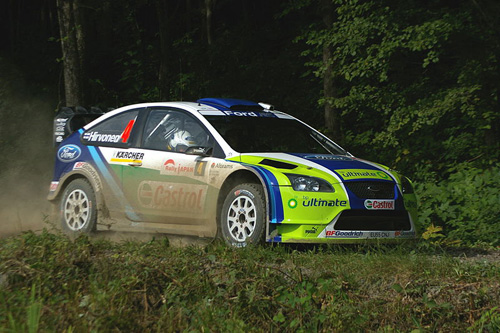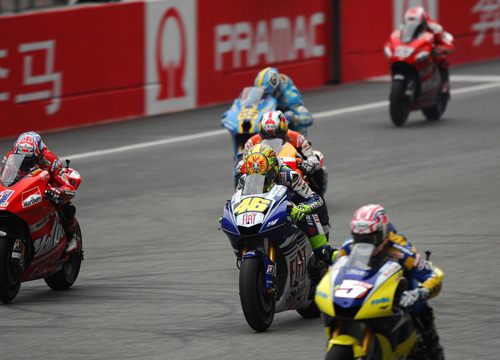When it comes to race day, what does Barugon watch?
 I’ve always been a big fan of motorsport, particularly series or events that call on the drivers, navigators, pit crews, and teams to exert a significant amount of technical skill and calculation. But isn’t that all motorsport, you say? Well, perhaps, to a certain extent, but I’ve never been convinced that a race series like NASCAR or IndyCar would qualify in my perspective… based in large part that much of their racing is conducted on a banked oval track. There is an old adage; four left turns a race does not make. My interests follow more of the international and European series, such as; Formula 1, World Rally Championship, MotoGP, the 24 Hours at Le Mans (24 Heures du Mans), and the Dakar rally.
I’ve always been a big fan of motorsport, particularly series or events that call on the drivers, navigators, pit crews, and teams to exert a significant amount of technical skill and calculation. But isn’t that all motorsport, you say? Well, perhaps, to a certain extent, but I’ve never been convinced that a race series like NASCAR or IndyCar would qualify in my perspective… based in large part that much of their racing is conducted on a banked oval track. There is an old adage; four left turns a race does not make. My interests follow more of the international and European series, such as; Formula 1, World Rally Championship, MotoGP, the 24 Hours at Le Mans (24 Heures du Mans), and the Dakar rally.
FORMULA 1
Who doesn’t love Formula 1!? Okay, there may be a few out there, but these last two seasons, particularly the 2008 season was phenomenal and I think signaled a real return of the sport. For those who don’t know, Formula One (often abbreviated to ‘F1’) is the highest class of open wheeled auto racing defined by the Fédération Internationale de l’Automobile (FIA), the motorsport world governing body. The ‘formula’ refers to the set of rules to which all participants and vehicles must conform. The F1 world championship season consists of a series of races, known as Grands Prix, which are usually held at purpose-built circuits, though in a few cases on closed city streets as well, such as the famous Monaco Grand Prix in Monte Carlo. The results of each race are combined to determine two annual World Championships, one for drivers and one for constructors. The vehicles can travel at very high speeds, particularly over short-distances, up to 360 km/h (225 mph), and are capable of pulling up to 5g in some corners. As a result of the speed and tight manoeuvring required, performance becomes highly dependent on sophisticated electronics, aerodynamics, suspension, and tyres combinations.
My favourite teams and drivers are the McLaren-Mercedes team and the BMW-Sauber team, with Lewis Hamilton, Heikki Kovalainen, and Robert Kubica topping my list of drivers. BTW – you may notice that Kazuki Nakajima (中嶋 一貴) is absent from that list… he’s a great guy, but he crashes out consistently (usually taking someone with him), and he hasn’t been a performer in Forumla 1, and that’s where it really counts 😐
Lewis Hamilton – Australia GP 2009

Robert Kubica – Canadian GP 2008

Start of the Turkish GP 2008

WORLD RALLY CHAMPIONSHIP
What could be better than watching cars drive down twisting country roads at break-neck speed, literally flying over crests, and producing some of the most spectacular crashes in motorsport? Not much, so thank goodness we have WRC! 🙂 The World Rally Championship, or WRC, is a rallying series organised by the FIA, which awards both a champion driver and manufacturer. The driver’s championship and manufacturer’s championship are separate competitions, however they are based on a linked point system. Each rally consists of varying numbers of stages (each of varying distances) on closed roads, though each stage is linked by open-road sections which are used by the public, requiring the manufacturers to create road-legal vehicles and the drivers to obey all road laws in whichever country they are present. The championship currently features 15 rallies and production-based 2.0 L turbocharged four-wheel drive cars built to World Rally Car regulations racing across tarmac, gravel and snow. The power output has been limited to 225 kW (~300 bhp).
Mikko Hirvonen – Rally Japan 2006

Petter Solberg – Rally Finland 2007

Daniel Sordo – Rally Sardinia 2008

MOTOGP
Barugon thinks that MotoGP is pretty darn sweet… it’s not something I watch all the time, but I always enjoy it when I do. In the world of motorcycling Road Racing World Championship Grand Prix is the premier championship, with bikes divided into three distinct classes: 125cc, 250cc and MotoGP. Grand Prixmotorcycles are purpose-built racing machines that are neither available for general purchase nor can be legitimately ridden on public roads; this contrasts with the SuperbikeWorld Championship, which features modified versions of road-going motorcycles available to the public. The competition is very international, with the current racing calendar consisting of 18 rounds in 16 different countries; including Spain, Qatar, Turkey, China, France, Italy, Great Britain, Netherlands, Germany, Czech Republic, San Marino, Portugal, Japan, Australia Malaysia, and the US.
MotoGP Race – Shanghai 2008

Casey Stoner crossing the finish line in Doha – Qatar 2008

24 HEURES DU MANS
Put simply, Le Mans is the stuff of legend… the 24 Hours of Le Mans (24 Heures du Mans) is an endurance race held annually since 1923 near the town of Le Mans in north-western France. Commonly known as the Grand Prix of Endurance, it is organised by the Automobile Club de l’Ouest. At a time when Grand Prix racing was dominating Europe, Le Mans was envisioned as a different test from motorsports at the time. Instead of focusing on the ability of a car company to build the fastest machines of the time, the 24 Hours of Le Mans would instead concentrate on the ability of manufacturers to build sporty yet reliable cars. This would drive innovation in not only reliable but also fuel-efficient vehicles, since the nature of endurance racing requires as little time to be spent in the pits as possible. The fact that the road is public and therefore not maintained to the same quality as some permanent racing circuits also puts more of a strain on parts, causing more emphasis on reliability.
While the classification of vehicles has varied over the years, there currently there are four; LMP 1&2 and GT 1&2. The first class, custom-built Le Mans Prototypes (LMP) occupies the top two classes; LMP1 and LMP2, which is further divided by speed, weight, and power output. The next two classes are production-based Grand Tourer (GT) classes; GT1 and GT2 which are also divided by speed, weight, and power output. The interesting aspects as a spectator are the sheer variety of vehicles, the incredible endurance that the vehicles must withstand, and the skill of the drivers and teams to complete hour after hour of racing in any weather condition.
Aston Martin race team – Le Mans 2007

Audi R10 crossing the finish line – Le Mans 2007

DAKAR
The Dakar is without doubt one of the most difficult single rallys, and has a uniqueness all its own. Formally called Paris-Dakar, this rally has morphed over the years into a variety of routes, including Paris–Cape Town, Granada–Dakar, Marseille–Sharm ash-Sheikh, Barcelona–Dakar, and Lisbon–Dakar. The 2008 race has been cancelled for a variety of reasons, but the principle issues were security concerns after an al-Qa’ida affiliate organisation killed four French tourists on 24 December 2007 in Mauritania, where the rally would have spent eight days. Al-Qa’ida stated that the rally was ‘neo-colonialist’, and accused Mauritania of providing support to ‘crusaders, apostates and infidels’ – typical al-Qa’ida nonesense! For 2009 the rally is crossing the Atlantic to South America, with the course taking participants from Argentina to Chile and back again.
There are essentially three classifications; Moto, Car, and Lorry. The Moto class has three sub-groups, which comprise stock motorcycles, heavily modified motorcycles, and quads. The Car classification is split into three sub-groups; T1, T2, and Open, with most entries being either stock production or improved cross-country vehicles. The last class, Lorry (also referred to as ‘Camion’ or ‘Truck’), is further split into to sub-groups T4 and T5, with T4 being trucks that actually compete in the rally, while T5 vehicles cover many of the same routes but are non-competing support vehicles for all of the classifications.
Moto class KTM riders – Dakar 2006

Car class Bowler Wildcat – Dakar 2007

Lorry class Unimog U400L – Dakar 2006

よいいちにちを!
– Barugon (^_^)

Leave a comment